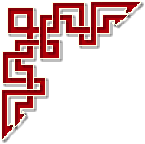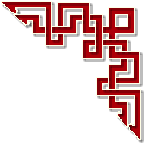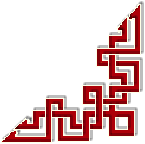|
 Introduction Introduction 
Today's topic is an introduction to Tantra.
It is extremely important to make a few things clear about the
Tantra approach since it is nowadays a very wide-spread approach,
but because of its depth, it leads to many misunderstandings.
 Tantrayana is quicker than Sutrayana Tantrayana is quicker than Sutrayana 
Somehow it is
understandable that Tantra has spread so much in the West because
usually westerners like quick, instantaneous things. There is
instant coffee, instant soup, instant noodles, ... Thus, it is
normal that nowadays people are seeking for instantaneous
enlightenment! Even though, clearly, it is not possible to reach
enlightenment as quick as an instant coffee, but there are quicker
ways than some others.
Within the Sutrayana it is said that in
order to reach Enlightenment, it takes eons (kalpas), namely three.
This may not mean much too you, but it is a long time. I think I
have read somewhere that a small kalpa is 84.000 years - I don't
know how long can be a big one (a mahakalpa), and here we are
talking about three. On the other hand, it is claimed, that within
the Tantrayana it is possible to reach enlightenment in one
lifetime... which makes quite some
difference.
The sutra approach most
of the time is to consider that the main root of the samsara are the
wrong views, desire/attachment. The Sutrayana therefore asks to
treat pleasure and desire as a poison. The approach of the Tantra
is to say that some toxic plant could also be a very good medicine.
The Tantra approach is to try to see where is the strongest
energy within ourselves. Tantra will try to find this strongest
source of energy, whereever it is, and to use this energy toward the
goal. If we analyse a little bit our life, and if we analyse by what
our mind is usually disturbed, it is clear that desire is our
strongest energy. So, the Tantra will try to approach that big
source of energy and will try to transform it.
 About using energies About using energies 
There can be a
kind of apparent contradiction between what the Tantras say and what
is usually admitted, because most of the religions, including
Sutrayana Buddhism, preach to refrain from desires. Most of the time
we can hear about rejecting all good times and refraining from every
kind of pleasurable sensations and to see the body as a source of
all poisons. While the Tantra will rather tend to analyse what is
behind the pleasure, behind the desire, and will try to use it for
its goal. Somehow the Tantrayana says that there is nothing bad
about the pleasure by itself, but the source of the problems is
coming from the grasping we usually have towards the pleasure. The
main problem comes from the attachment we can develop, but not from
the pleasure itself.
We have to clearly
understand at this point that the main motivation and the main basis
for Tantra is Bodhicitta, the Awakening Mind. Even though the
Tantric Path is known to be the quickest path and is known to bring
quick results, we should not understand it the way that we can skip
the usual preliminaries. It does not mean either that there is no
need of any discipline or any patience. For whoever has not done
enough preliminaries, enough purifications and enough accumulation
of merits, the Tantrayana may be a difficult path instead of being
the quickest one. For somebody who has not developed Bodhicitta well
enough, the Tantrayana will be an empty path. The only good result
we can get out of the tantric path is coming from the strong
Bodhicitta motivation. To be clear, when we are talking about
'Bodhicitta', it is meant as the 'Awakening Mind' and not only in a
frequent translation as 'compassion'.
The core idea of the Awakening Mind is to become aware of the
suffering of all sentient beings without exception, and this with a
sense of equanimity which means that we hold all sentient
equally dear. Bodhicitta is also something which goes together with
non-attachment, in order to reach that state of equanimity. That's
why some people might have thought sometimes that this is close to
'indifference', while it is of course completely the opposite;
suddenly one's mind starts to care about each single sentient being
in exactly the same way as we would care for the dearest person we
have. As a prerequisite to Tantra, we have to meditate on our
motivation and analyse it well
enough.
If we are looking at our
daily life, and our past and actual way to react, we can easily see
that we seek for happiness outside of ourselves. And so far, every
time that we have been seeking outside of ourselves for an ultimate
happiness, we have failed. We could have found some instant, some
moment of happiness, but most of the time, there is more a feeling
of insatisfaction. We do not get all that we expect from outside.
The tantric path teaches that we all contain within ourselves all
the energies that we need, and that we all do contain the male and
female energies within ourselves. Most of the time, a male being
seeks for the female energy outside of himself, and a female being
seeks for the male energy outside of herself; and it brings much
more insatisfaction than ultimate pleasure. Nevertheless, we spend a
huge amount of energy and time into this external search, and the
Tantra somehow seeks to use that strong energy in order to transform
it. It does not mean at all that to practice Tantra is to indulge
into pleasure! It is taught that it is much more the way how we are
usually looking at the desires which is disturbing the clear
perception we could have of the reality. It is the amount of
projections which we all the time create and superpose on reality
that brings us a lot of insatisfaction. We could therefore say that
our insatisfaction is our 'syndrome of lack'. We lack a type of
energy, we lack a type of experience which we therefore seek
outside.
 Types of Tantra Types of Tantra 
Within the
Tantra we talk about four tantric classes: Kriya, Charya, Yoga, and
Maha-Anuttarayoga:
Kriya Tantra - Purification - (bya
gyü):
It emphasizes rituals as very important. We see
ourselves as being deluded, while the deity is worshipped as having
all the power to impart to us.
Charya Tantra - Action -
(chö gyu):
There is a more balanced emphazise on both
meditative states and ritual observances. The Deity is seen as
closer to us, and is understood to be no different from one's own
Buddha-nature, or the nature of mind.
Anuyoga Tantra - Union
- (jesu naljor gyü):
The practitionner relies less and
less on relative truth and aims more toward absolute truth. From
here, one must have taken absolutely the Bodhisattva vows.
Its is
explain how defilements and delusions can be transformed into
wisdom, and therefore the delusions are an important material we
have to deal with - instead of abandonning - as it can give rise to
insight and wisdom if dealt in a proper way.
Maha-anuttarayoga - Supreme Union - (la-me chenpo'i
gyü):
It is the most difficult one to practice. From here,
one must take the Tantric vows, and undertake some daily commitments
(Samaya). The practitionner deal direclty with his/her conflicting
emotions and delusions.
We
could as well devide the Highest Tantra in three, according to the
'poison' it will directly focus on. The Three Poisons (kleshas)
being: Ignorance, Passion and Aggression. Though we shouldn't think
one Tantra "lack" anything, it is only a matter of
emphasis.
Father Tantra: practicing utilizing mainly
aggression as the path, focusing on the Emptiness aspect of
Buddhanature. Like Guhyasamaja and Yamantanka, as well as the
practices of the illusory body and of dream yoga.
Mother
Tantra: utilize mainly passion as the path, focusing on the
luminosity aspect of Buddhanature. It includes Chakrasamvara, tummo
(heat generation), and clear light yoga.
Non-dual
Tantra: practicing equally passion and anger - counteracting
Ignorance - with equal focus on the luminosity and Emptiness aspects
of Buddhanature. Include Kalachakra, Hevajra and the yoga of
Bardo.
 Union Tantra (AnuttarayogaTantra) Union Tantra (AnuttarayogaTantra) 
So, from this
point there are a few misunderstandings in the west, when we talk
about "Union" Tantra, and the misunderstanding is even stronger when
people look at some thangka paintings, the traditional esoteric
paintings. There are clearly some people who mixed a little bit
Tantra paintings with kamasutra representations. But Tantra
paintings, when you see a male and female Buddha in union, have to
be understood from a symbolic point of view. As it is said that the
male energy represented on such a thangka is the great Bliss, and
the female energy symbolized in such paintings is non-dual Wisdom,
Emptiness. This has to be clear, because we can hear a lot of quite
strange things sometimes, and we can read in some magazines some
very weird Tantra training. But Tantra is by no way indulging into
pleasure, Tantra is a way to use desire. It is compared
sometimes to termites in the wood. Because the termites are actually
using the wood, but at the same time, they are destroying the
support. In the same way we could say that the tantric path uses the
desire in order to reach the non-dual Wisdom, and once this non-dual
Wisdom is realized, in return it burns the source of it, it destroys
the desire by itself.
The
Tantra path is a way to transform our daily perception. It tries to
fight against the usual underestimation that we tend to have about
ourselves. It tries to strengthen one's motivation into the
practice. It tells you that you have some desire and that you think
you might not understand exactly what is Emptiness and such things,
but still deep inside yourself you have the Buddha nature which is
able to understand and which is able to transcend everything. The
main mistake is to see our environment on an ordinary basis, to see
it as all mistaken. Thus, Tantra is a step by step training for the
transformation of our perceptions.
 The three bases The three bases 
We can say
that in order to progress on the tantric path, we need to develop
what we call the three main bases. The first is Renunciation; the second is Bodhicitta; and the third is Emptiness. We could say the these three bases
are the same as developed in the Sutrayana. But the renunciation
will be seen not as rejecting the source of pleasure, but as working
on our perceptions and on our attachment to
pleasure.
When we talk about the
illusory aspect of all phenomena around us, we tend to make the
comparison with a dream. And we try to train ourselves in order to
be able to see the various phenomena that we are encountering as
unreal as a dream perception can be. Within the practice often you
will meet autovisualization of ourselves as the Deity, as the
Buddha. And it is emphasis on the fact that our deep, our
transcendental nature is of the nature of a Buddha.
 Divine pride Divine pride 
What is tried
to be achieved is an identification with the Deity, with an
archetype. And this archetype is the one of a Buddha, of somebody
having full Enlightenment. Surely at the beginning of such a
practice, we are doing it a bit artificially, but step by step we
will deepen our belief in the autovisualization. And slowly, we will
believe strongly that while doing this autovisualization, we are the Deity. And we are
reaching now to a concept which is important in Tantra, which is
'divine pride'.
Here again, it
seems to be a little bit contradictory with what we usually hear
about the practice, because it is often said that we should throw
away any kind of pride from our consciousness. And here it seems
that I am saying you should be proud. But the main difference is
that most of the time the pride we generate is a pride towards the
grasping of a self-identity, while in the Tantra, when we talk about
divine pride, it is because we become proud to be the Buddha, to be
the Deity, with all his/her qualities, not forgetting the point that
your main, ground motivation is Bodhicitta. Thus, you are not
developing a pride in order to gain something for your little self,
but you develop the pride to be the Buddha, to be a fully
enlightened being for the sake of all sentient beings, for being
able to help.
 The abrupt path The abrupt path 
And at the
same time, you will understand why, when we talk about Tantra, we
call it as well the quickest path, but we may also call it an
'abrupt path', because an abrupt path will lead you quicker to the
goal of the path, but if you fall, then the fall is also harder.
Thus, the tantric path is indeed able to help us to reach the goal
quicker, but if we do not follow with a very strong autodiscipline,
precisely listening the advice of a fully qualified Master, then it
may end in a disaster.
When we
are talking about using the power of desire, we can give here a kind
of example. It is like when you see one person, one being which your
mind describes as extremely beautiful and desirable, this launches
in your mind a lot of desire toward that appearance. In front of
such appearance and with the same amount of desire, the practice
would be to mentally transform such an object into a rainbow. So,
somehow you remain with that type of very strong energy, but you
don't have anymore the first object of your desire, of your
attachment. And keeping that same energy through a meditation, you
transform that energy into a blissful state of mind.
By
repeating such exercise a bit more developed, the mind will reach a
much clearer state of bliss.
 The qualified master The qualified master 
Two things are
fundamental in order to practice Tantra: the first is to find the
right teacher, the right guide, which will embody all the qualities
of the Buddhas, and the second thing is that you get from that
qualified teacher a tantric Initiation. The Initiation is
fundamental in the sense that it brings a contact between our
consciousness and an unbroken lineage of trans-mission from the
Buddha to our consciousness. It is somehow to be considered as an
activa-tion of our inner qualities. An Initiation does not bring
anything into your mind else than a blessing to awaken you own
Buddha qualities. An Initiation is not to be seen just as a ritual,
as a sum of mouvements and funny phrases, but it has to be
experienced from inside. One has to exactly follow the different
steps of that Initiation and to keep always a clear identification
of the master with the Deity from whom we receive the Initiation.
We could easily say that a mere intellectual understanding of
the different steps of an Initiation is not enough at all, it really
has to be something which we 'live' from inside, that we go through
from inside, that we experience from inside. Why from inside?
Because within ourselves there are some specific components which
have to be activated, which have to be switched on through the power
of the Initiation and through the power of our visualisations.
Within our physical body we have something more subtle which we call
the 'Vajra body', which is composed of thousands of channels and
subtle energies. In the ordinary time, all our energies are flowing
here and there in different channels, everywhere else than in the
central channel - while, if we would be able to concentrate and
focus and dissolve all these disturbed winds/energies into that
central channel, then we could experience a State of Great Bliss. So
we have to search for the methods that will help to concentrate, to
control and to bring those energies into the central channel. The
realization that can be experienced once all winds are dissolved
into the central channel is Emptiness.
 Realization of emptiness Realization of emptiness 
So we can see
from now that there are two main ways to realize emptiness: it would
be the analytical way through following step by step a scholastic
text which depict exactly what is and what is not, and the second
way is to operate control over the inner winds of our body and to
engage them into the central
channel.
We should not oppose one
way to another; these are two ways which have been taught by the
Buddha and which correspond to different types of beings. We could
say briefly that on one side there are people who have low desire
and low attachment and who are very methodic in their way to learn,
and for them the Sutra Path would be more appropriate. And on the
other side, there are other people who feel quite 'wild' inside and
have difficulties to control their desires, who have very strong
desires, and for those, according to the strengths of their desires,
they might fit into one of the four tantric
classes.
The Tantra path is
dedicated to those minds who do not have a very low self-estimation.
This is clearly a method which is opposed to a low self-estimation,
opposed to discouragement as well.
 Identification visualization Identification visualization 
Within the
Tantra, among the first practices, there is an autovisualization as
the Deity, and at some point, the Deity, by visualization, dissolves
into what is called the 'Clear Light'. At that moment, one's mind
has to be as identified as much as possible to that clear light.
Without any doubt about the reality of what is experienced. It is
clear from one point that the experience at that moment is not the
experience of Clear Light, but the goal is a less solid
misconception. Once your mind is dissolved into this clear space,
there is less chance to find a "I". If your mind can really dissolve
into that clear light, and identify itself with that clear light,
then we can say that the mind is approaching the concept of
emptiness.
At this point, you might
say somehow: "Eh, Shenphen! There are so many deep descriptions
by Nagarjuna and many others about the different steps to reach
emptiness, that it might not be possible that by such easy
meditation we might understand it!"
We could answer, that,
here, it is not a question of study, but of action and of
experience. The main goal here is to decrease the amount of
misconceptions, to decrease the power of self-grasping, in order to
make our consciousness as subtle as possible. From the Tantrayana
point of view, we could say that the strict intellectual approach is
more an obstacle than a help. The main point here is to be able to
identify your mind with the qualities of the Buddha; you should not
think that you are doing this in a fake way, but you really develop
the divine pride that your consciousness has reached a state of a
Buddha's consciousness. It is a state that seeks stopping the
babbling of the mind and to decrease the usual expectations. It is
necessary for that to do not generate any tension on an expected
result, but just to be the Deity, the Buddha's consciousness, and to
let go everything else. And once your mind is within that state of
bliss, then you look at all the appearances as coming from that
emptiness.
 Questions Questions 
Q. When those energies are going to
the central channel, what happens to them?
A. They dissolve into the central channel,
they disappear into the central channel, they do not exist in the
same way within the central channel as they do outside. This stops
the babbling of the mind which is maintained and produced by all the
different winds in the other channels. By focussing all those winds
into the central channel, it stops the babbling of the mind and
allows the mind to have a much deeper, subtle, state.
[.....
|














